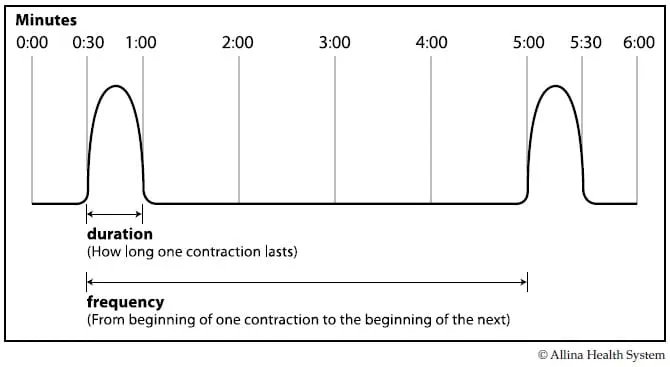
Timing contractions
Timing your contractions will help you and your health care provider track what is happening. You will need to know how long your contractions last (duration) and how close together they are (frequency).
Duration is timed from when you first feel a contraction until it is over. This time is usually measured in seconds.
Frequency is timed from the start of one contraction to the start of the next. It includes the contraction as well as the rest period until the next contraction begins. This time is measured in minutes.

It is not necessary to time your whole labor. You may want to start timing your contractions when you think labor has started to see if there is a pattern.
You may also want to time contractions for a bit after there has been a change in how the contractions feel. That can give you a better idea of how much time you have to rest between each contraction. It can also help you decide when to go to the hospital.
Keeping a written labor log can help you see the pattern of your contractions. Partners and labor companions usually are the ones who time the contractions and keep the log. However, it is more important that you get the labor support you need than to have a complete labor log.
When you call your health care provider or hospital, you will need to give information about the duration and frequency of your contractions and about how long this has been the pattern.
Here are some terms you can use to describe the pattern of your contractions:
- Regular contractions. Contractions are considered regular when the duration and frequency are stable over a period of time. An example is contractions lasting 60 seconds and coming five minutes apart for an hour.
- Irregular contractions. Contractions are irregular when there isn't a stable pattern. An example is a series of three contractions lasting between 30 and 45 seconds and coming 10, seven and then 15 minutes apart.
- Progressing contractions. Contractions that are lasting longer and getting closer together are considered to be progressing. Over the course of labor, contractions get longer, stronger and closer together.
- Nonprogressing contractions. Contractions that are not getting longer, stronger and closer together. This may mean that the contractions are not opening the cervix. It usually means that other work is being done, such as turning your baby to a different position, softening or thinning the cervix.
Related resources